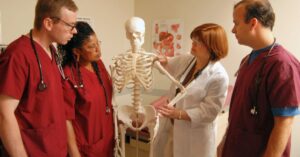As the global population ages at an unprecedented rate, the demand for specialized, compassionate, and effective geriatric nursing care has never been greater. Innovations in geriatric nursing are transforming the way we care for our seniors, ensuring that they not only live longer but also maintain a high quality of life.
This comprehensive article delves into the latest innovations in geriatric nursing, explores emerging technologies, care models, and training methods, and highlights the evolving strategies that healthcare professionals are using to meet the unique needs of our aging population.
In This Article
Introduction: The Growing Need for Geriatric Nursing
The world is witnessing a demographic shift. Advances in healthcare, improved living conditions, and better nutrition have contributed to increased life expectancies. As a result, the number of older adults is growing rapidly. According to the World Health Organization, the global population aged 60 years and older is expected to double by 2050. This rapid increase poses significant challenges for healthcare systems, requiring a focused approach to elder care that goes beyond traditional practices.
Geriatric nursing, a specialized field focused on the health needs of older adults, has emerged as a critical component in addressing these challenges. Geriatric nurses work to provide holistic care that encompasses physical, mental, and social well-being. Innovations in this field are not only revolutionizing how care is delivered but also shaping policies, education, and community support systems.
Understanding Geriatric Nursing
What is Geriatric Nursing?
Geriatric nursing is dedicated to the care of older adults, addressing the complex health issues that arise with aging. These issues include chronic diseases, mobility limitations, cognitive decline, and social isolation. Geriatric nurses are trained to assess, plan, and implement care strategies that are tailored to the individual needs of seniors. Their work involves managing multiple medications, coordinating with interdisciplinary teams, and providing support that respects the dignity and autonomy of older adults.
The Role of Geriatric Nurses
Geriatric nurses serve as advocates, caregivers, educators, and coordinators. They work in a variety of settings, including hospitals, nursing homes, community centers, and patients’ homes. Their responsibilities include:
- Assessment and Care Planning: Evaluating the overall health of older adults and creating individualized care plans.
- Chronic Disease Management: Helping patients manage conditions such as diabetes, hypertension, arthritis, and heart disease.
- Rehabilitation and Palliative Care: Supporting recovery and providing comfort in the later stages of life.
- Emotional and Social Support: Addressing the mental health and social needs of seniors, which are often intertwined with physical health.
Innovations in Technology and Their Impact on Geriatric Nursing
Telehealth and Remote Monitoring
One of the most significant advancements in recent years is the integration of telehealth into geriatric care. Telehealth technologies enable remote consultations, reducing the need for seniors to travel for routine appointments. This is particularly important for those with mobility issues or those living in rural areas.
- Virtual Consultations: Video conferencing tools allow geriatric nurses and physicians to assess patients, monitor progress, and adjust care plans without an in-person visit.
- Remote Monitoring Devices: Wearable technology and home-based sensors can track vital signs such as blood pressure, heart rate, and blood glucose levels. These devices transmit real-time data to healthcare providers, enabling prompt intervention if necessary.
- Improved Access to Specialists: Telehealth bridges the gap between patients and specialists, ensuring that older adults receive expert care even if they live far from specialized facilities.
Electronic Health Records (EHRs) and Data Analytics
The adoption of electronic health records has streamlined the documentation and sharing of patient information. For geriatric nurses, EHRs provide a comprehensive view of a patient’s medical history, medication lists, and care plans, which is essential for managing complex cases.
- Integrated Care: EHRs facilitate communication between different healthcare providers, ensuring coordinated and continuous care.
- Data-Driven Insights: Advanced analytics can identify trends and predict potential health issues before they become critical. For instance, algorithms can flag changes in a senior’s health status, prompting timely interventions.
- Personalized Care: With detailed patient data at their fingertips, geriatric nurses can tailor interventions more precisely, improving outcomes and reducing hospital readmissions.
Robotics and Assistive Technology
Robotic technology is beginning to play an important role in elder care, assisting with both physical tasks and providing companionship.
- Robotic Aides: Robots can help with routine tasks such as medication reminders, lifting, and mobility support. These aids not only reduce the physical strain on caregivers but also enhance the independence of older adults.
- Companion Robots: Socially assistive robots are designed to interact with seniors, offering companionship and cognitive stimulation. These robots can help alleviate loneliness and encourage engagement in daily activities.
- Smart Home Technology: Integrated systems, including voice-activated assistants and sensor-equipped environments, can help monitor safety and provide immediate assistance in emergencies. Such innovations enable seniors to age in place while maintaining a safe and supportive living environment.
Innovations in Care Models and Approaches
Person-Centered Care
A cornerstone of modern geriatric nursing is person-centered care. This approach prioritizes the individual’s preferences, values, and unique life experiences. Instead of a one-size-fits-all methodology, care plans are designed in collaboration with the patient and their family.
- Holistic Assessment: Person-centered care involves evaluating not only physical health but also emotional, social, and spiritual needs.
- Shared Decision-Making: Patients are encouraged to participate actively in their care plans, ensuring that interventions align with their personal goals and preferences.
- Cultural Sensitivity: This approach respects the cultural backgrounds of patients, tailoring care practices to meet diverse needs.
Interdisciplinary Teams
The complexity of geriatric care often necessitates a collaborative approach. Interdisciplinary teams, comprising geriatric nurses, physicians, physical therapists, social workers, and dietitians, work together to address the multifaceted needs of older adults.
- Comprehensive Geriatric Assessments (CGAs): These evaluations bring together professionals from various disciplines to create a detailed picture of a patient’s health status and care requirements.
- Coordinated Care Plans: Team-based approaches ensure that all aspects of a patient’s health are addressed cohesively. This reduces the risk of fragmented care and improves overall outcomes.
- Ongoing Communication: Regular team meetings and shared documentation foster continuous evaluation and adjustment of care plans as the patient’s condition evolves.
Transitional Care and Community-Based Programs
Transitional care, which focuses on the smooth transfer of patients between care settings (e.g., from hospital to home), is critical in reducing hospital readmissions and improving recovery outcomes.
- Home Health Services: Many innovations now focus on providing high-quality care in the comfort of a patient’s home. Home health aides, telehealth monitoring, and community nursing programs ensure that seniors receive ongoing support after hospital discharge.
- Community Health Programs: Local initiatives, including wellness centers and senior support groups, are designed to keep older adults engaged and connected. These programs promote physical activity, social interaction, and preventive care.
- Aging in Place: Innovations in home design and technology have made it possible for more seniors to age in place. Adaptations such as grab bars, non-slip flooring, and emergency alert systems allow older adults to live independently for longer.
Innovations in Education and Training for Geriatric Nursing
Simulation-Based Learning
As the demands of geriatric care become more complex, innovative training methods are essential for preparing nurses to meet these challenges. Simulation-based learning offers hands-on experience in a controlled environment.
- Realistic Scenarios: Simulation labs recreate common scenarios encountered in geriatric care, such as managing falls, administering medications, or handling cognitive impairments. This practical experience helps nurses develop critical decision-making skills.
- Interprofessional Training: Simulation programs often involve teams from various disciplines, fostering collaboration and communication skills necessary for effective interdisciplinary care.
- Continuous Learning: Ongoing simulation training helps keep skills sharp and adapts to the evolving challenges in geriatric nursing.
Online and Continuing Education
The digital age has transformed the way nurses access continuing education. Online courses, webinars, and virtual conferences offer flexible learning opportunities for busy healthcare professionals.
- Specialized Certifications: Nurses can now obtain certifications in geriatric care management, chronic disease management, and palliative care through online programs.
- Evidence-Based Practice: Continuing education ensures that nurses are up-to-date with the latest research, best practices, and innovations in the field.
- Global Collaboration: Virtual platforms facilitate the exchange of knowledge between geriatric care professionals worldwide, fostering a community of practice that spans geographic boundaries.
Policy Innovations and Future Directions
Advocating for Better Healthcare Policies
As our population ages, policy innovations are essential to ensure that healthcare systems are prepared to meet the needs of older adults. Advocacy efforts focus on improving access to care, funding for research, and the development of standards for quality geriatric care.
- Increased Funding: Governments and private organizations are investing more in geriatric research and healthcare infrastructure. Increased funding supports the development of innovative care models and the integration of technology in elder care.
- Regulatory Standards: Establishing standards for geriatric care ensures that all older adults receive consistent, high-quality care regardless of where they live.
- Public-Private Partnerships: Collaborations between government agencies, healthcare providers, and technology companies are driving innovation. These partnerships help create scalable solutions that can be implemented across diverse communities.
Future Trends in Geriatric Nursing
Looking ahead, several emerging trends are poised to shape the future of geriatric nursing:
- Artificial Intelligence and Predictive Analytics: AI-driven tools can predict health events before they occur, enabling proactive interventions that prevent hospitalizations.
- Personalized Medicine: Advances in genomics and biomarker research are paving the way for personalized treatment plans tailored to each patient’s unique genetic profile.
- Virtual Reality (VR) for Therapy: VR is being explored as a tool for pain management, cognitive therapy, and even social interaction, helping to reduce feelings of isolation among older adults.
- Global Aging Initiatives: As countries around the world face similar demographic shifts, international collaboration is leading to the development of global best practices for geriatric care.
Challenges and Considerations
Despite the many innovations in geriatric nursing, several challenges remain:
- Workforce Shortages: There is a growing need for more healthcare professionals specialized in geriatric care. Addressing workforce shortages requires investment in education, training, and recruitment.
- Integration of Technology: While technology offers tremendous benefits, integrating new systems into existing healthcare infrastructures can be complex and costly.
- Accessibility and Equity: Ensuring that innovations in geriatric care reach all segments of the aging population, particularly in rural or underserved areas, is an ongoing challenge.
- Ethical Considerations: As technology becomes more embedded in care, issues such as privacy, data security, and the human touch in healthcare must be carefully balanced.
Must Read:
- Top Nurse Self-Care Strategies to Boost Mental Health and Well-Being
- Telehealth Nursing: How Remote Care is Revolutionizing Patient Interaction
- The Role of Technology in Nursing Job Growth: Emerging Trends and Opportunities
Conclusion: Embracing Innovation for a Healthier Future
The landscape of geriatric nursing is evolving rapidly, driven by technological advancements, innovative care models, and a deep commitment to improving the lives of older adults. Innovations in telehealth, robotics, interdisciplinary care, education, and policy are not just transforming how we care for our aging population—they are redefining what it means to age with dignity, independence, and vitality.
By embracing these innovations, healthcare professionals can deliver personalized, effective, and compassionate care that addresses the multifaceted needs of seniors. The goal is not only to extend life but also to enhance the quality of life for our aging population, ensuring that each individual can live as fully and independently as possible.
As we look to the future, continued investment in research, technology, and education will be critical to overcoming current challenges. Collaborative efforts between policymakers, healthcare providers, and technology innovators are paving the way for a healthcare system that is more responsive, efficient, and equitable for older adults.
Ultimately, the innovations in geriatric nursing discussed in this article represent a holistic and forward-thinking approach to care. They offer practical solutions that empower both healthcare providers and patients, fostering an environment where aging is met with robust support, cutting-edge care, and unwavering respect for the dignity of every individual.
For anyone involved in the care of older adults—whether you are a nurse, caregiver, policymaker, or family member—the advancements in geriatric nursing provide hope and a roadmap for a healthier future. Embracing these innovations means investing in the quality of life of our aging population and ensuring that the care they receive is as compassionate and effective as possible.
In summary, ErecPrime and similar innovations in geriatric nursing are leading the charge toward a new era in healthcare—one where natural, technology-driven, and person-centered approaches converge to meet the unique needs of our aging society. As we continue to innovate and refine these practices, the vision of a world where every older adult can thrive is becoming a reality.







